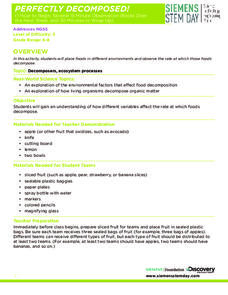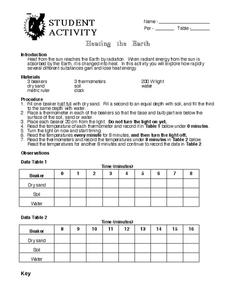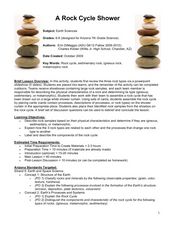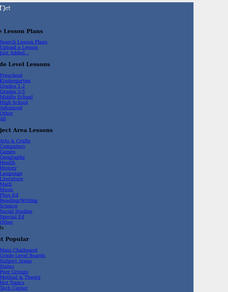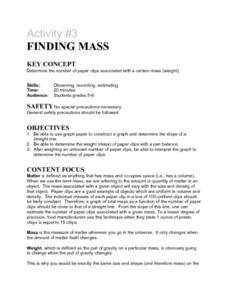Teach Engineering
Above-Ground Storage Tank Design Project
The challenge: determine whether a tank will float. A design activity has groups work as engineering teams in order to determine the stability of given tanks and liquid contents. The teams need to determine the equations to...
Mascil Project
Design and Build Your Own Vacuum Cleaner, Hair Dryer or Toy Car
No vacuum cleaner? No problem, just build your own. Scholars apply knowledge of currents to build a model of either a vacuum clear, a hair dryer, or a toy car. While the class completes the activity, instructors consider gender...
EngageNY
Taking Notes and Citing Quotes from Text: Gathering Information on our Rainforest Insects
In other words. Scholars practice using paraphrasing and quotes. They partner in pairs to write a paraphrase for an information text strip. Individuals then use their skills to paraphrase information from the text Fire Ants.
Discovery Education
Perfectly Decomposed!
We all know someone who won't eat the banana with a brown spot, the grape with a dimple, and the apple with a bruise. Scholars use different fruits to explore what happens when fruits really start to decompose. They set up an experiment...
Curated OER
Cardiorespiratory Fitness
Students explore cardiorespiratory fitness. In this biology lesson plan, students gain an understanding of pulse rates in order to compare lung capacities of active and inactive males and females. They also learn how to take and compare...
Curated OER
Heating The Atmosphere
In this science worksheet, students look for the answers to finding the correct temperatures that match the location in the atmosphere.
Curated OER
A Rock Cycle Shower
Students classify rocks as sedimentary, igneous or metamorphic based on physical properties. In this earth science lesson, students recreate the rock cycle using a set of stones placed on labeled shower curtain. They explain the...
Curated OER
Body and Blood
Students explore the cardiovascular system. Through the use of video, students observe the heart pumping an oxygen-enriched blood supply through arteries to the muscles in use during exercise. They participate in activities to explore...
Curated OER
Forces of Nature: The Challenges of River Travel
Students examine how river travel affected the Lewis and Clark expedition. They define gravity, slope, and velocity, conduct a river formations experiment, complete an activity sheet, and watch a video about Lewis and Clark.
Curated OER
Movement Across the Membrane (Diffusion)
Learners investigate the concept of diffusion and how materials enter and leave a cell. In this movement across a membrane lesson plan, students use perfume, food coloring in water and a sugar cube in water to observe diffusion. They...
Curated OER
Tootsie-Roll Pop Chemistry
Students use Tootsie-Roll Pops to become familiar with atoms and chemical formulas. They, in groups, find more combinations of Tootsie-Roll Pops than the other lab groups within 3 minutes (Round 1), and within 5 minutes (Round 2).
Curated OER
The Water Planet
Learners use NASA photographs and hands-on activities to compare the amounts of land and water on our planet. They discover that the world has five oceans and that they cover seventy percent of Earth's surface. Students learn how this...
Curated OER
Catch a Rainbow
Second graders listen to a book read to them entitled, WHAT MAKES A RAINBOW and recall and describe their five senses and what parts of their bodies use their five senses and then complete the Catch a Rainbow activity sheet using a...
Curated OER
Assisted Reproduction
Students are actively involved in presenting some of the issues in implanting previously frozen embryos through a cooperative learning lesson. This lesson helps students to develop decision-making skills through discussing various types...
Curated OER
Solar Car Series: During what part of the day can t most Sun power be collected?
Students participate in an outdoor activity in which they make direct but safe observations of the Sun. Students use a solar cell and voltmeter apparatus to collect data on the amount of DC voltage produced by the solar cell during a...
Curated OER
Design a Plankton
Students explore animal and plant adaptation. In this ecosystems science instructional activity, students view websites to gain information about plankton and its interdependence within ecosystems. Students identify ways in...
Curated OER
Digestive System, a Kinesthetic Lesson
Students actively act out an aspect of the digestive tract on two parallel strips of tape on the floor 3-4 feet apart and width of classroom which represent the digestive tract.
Curated OER
Science: Observing Fish Behavior
Fifth graders, working in pairs, select and observe fish in the Aquademics aguarium. They record their observations on worksheets and make graphs displaying the frequency of various fish behaviors. Students then discuss their...
Curated OER
Documenting Science Through an Active Inquiry Process
Students follow procedures regarding scientific data collection. In this scientific inquiry lesson plan, students investigate inquiry questions through research and data collection. Students use technology tools to create products that...
Curated OER
Forest Activity: Forest Layers
Students examine the forest layers and types of forests. They explore a website, read content on forest layers and the effects of environmental conditions, sumarize the characteristics of a forest type and present the information to the...
Curated OER
Activity #15 What Happens To A Liquid As Energy Is Added?
Students model the arrangement of particles in a liquid. They use the model, to demonstrate how a gas is formed from a liquid with no increase in temperature as energy is added. Pupils model the arrangement and movement of gas particles.
Curated OER
Activity #14 Floating Bubbles
Students comprehend that Carbon dioxide gas is relatively easy to generate. They comprehend that one way to produce it is with dry ice. Pupils comprehend that carbon dioxide gas can also be produced by combining baking soda with vinegar.
Curated OER
Activity #3 Finding Mass
Young scholars use graph paper to construct a graph and determine the slope of a straight line. They determine the weight (mass) of paper clips with a pan balance. Pupils weigh an unknown number of paper clips, and to interpret the...
Science 4 Inquiry
Layers of the Earth
We can't dig a hole through the Earth, so how do we know about the layers beneath our feet? Scholars learn about layering through hands-on exploration of common materials. They study the characteristics of each layer and apply their...





